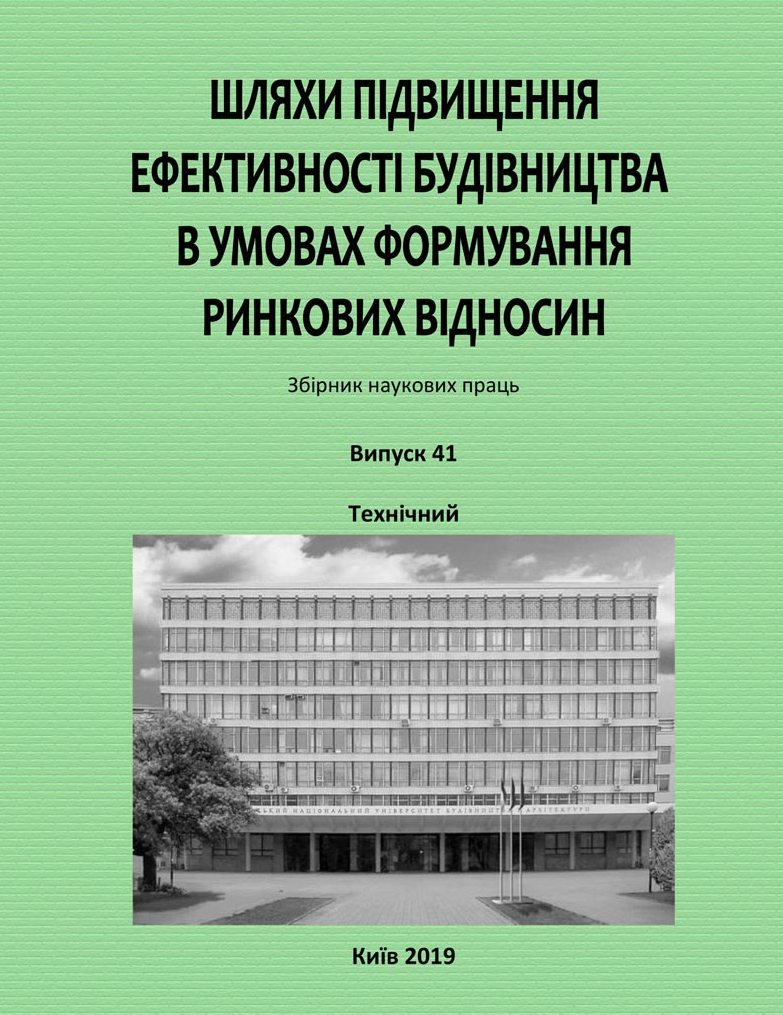Improvements of the approaches to the organization of thermomodernization on the example of bilding of the general education school
DOI:
https://doi.org/10.32347/2707-501x.2019.41.106-118Keywords:
thermo-modernization, organization of construction, evaluation of design decisions, choice of organizational decisionsAbstract
Features of thermo-modernization which require development of separate organizational decisions are considered, among which: thermo-modernization can be carried out during different types of construction (reconstruction, major repairs, technical re-equipment), but unlike these types of construction can be carried out without suspension of operation of objects, adopted organizational and structural decisions to improve the energy efficiency of building envelope structures determine the technology of work execution and vice versa Ongoing decisions often affect the organization of the construction process, payback is provided by cost savings from the implementation of energy efficient measures, the list of output data for the design is wider than for a regular construction project and is not limited to the data of the old project or BTI data, there are no regulatory requirements for the design task and implementation of the section "Energy Efficiency", etc. The analysis of the most widespread structural and technological solutions used in thermo-modernization showed that it is impossible to make the choice of the optimal solution for an individual enclosure structure only by a direct evaluation of the physical, mechanical and technical and economic characteristics.
It is proposed to choose the optimum structural and technological solution in thermo-modernization projects from all possible in two stages. In the first stage, it is necessary to reject those decisions, the implementation of which for this type of building is technically impossible or economically or technically inappropriate. The second is the assessment of structural and technological solutions on the basis of such global criteria as reliability, environmental friendliness, economy and relevant sub-criteria. The weight of the criteria and sub-criteria is determined by the method of expert judgment, taking into account the purpose of the building for which the decisions are selected.
An example of the implementation of the proposed approach is given on the example of a typical project of school thermo-modernization. As a result of generalization of the most widespread structural and technological solutions, characteristics of thermo-modernization projects, requirements for energy efficiency of buildings, and those that are applied to structural and technological solutions, a set of possible criteria for selecting the optimal solutions is determined.
References
Law of Ukraine "On Energy Efficiency of Buildings" of 22.06.2017 No. 2118-VIII. URL: https://zakon.rada.gov.ua/laws/show/2118-19.
DSTU-N B V.3.2-3:2014 (2015) Nastanova z vykonannia termomodernizatsii zhytlovykh budynkiv K.: DP «Arkhbudinform».
DSTU-N B А.2.2-13: 2015 “Energy efficiency of buildings. Guidelines for the energy assessment of buildings. URL: https://thermomodernisation.org/wp-content/uploads/2017/11/1783_-__.2.2-13_2015.pdf.
DBN B.2.6 - 31: 3006 "Thermal insulation of buildings" (2006), Minregionbud, Кyiv.
Enerhoefektyvnist v munitsypalnomu sektori. Navchalnyi posibnyk dlia posadovykh osib mistsevoho samovriaduvannia (2015) / Maksymov A.S. ets. – AMU, USAID.
Bielienkova O.Iu., Tsyfra T.Iu., Matsapura O.V. & Ostapenko I.O. (2018) Ekonomichna otsinka zakhodiv z pidvyshchennia enerhoefektyvnosti. Shliakhy pidvyshchennia efektyvnosti budivnytstva v umovakh formuvannia rynkovykh vidnosyn. 36.78-82.
Maksymov, A.S., Dovhaniuk, V.M., Vakhovych, I.V., Tsyfra T.Iu. (2013) Tekhniko-ekonomichne obgruntuvannia zakhodiv z pidvyshchennia enerhoefektyvnosti obiektiv nevyrobnychoho pryznachennia. «Zelena» ekonomyka – shliakh do staloho rozvytku: zb. Materialiv /uporiad.O.S. Chmyr. – K.
Izmailova, K.V. (2018) Ekolohichnyi suprovid zapasiv yak chynnyk efektyvnosti vykorystannia oborotnykh zasobiv budivelnoho pidpryiemstva. Shliakhy pidvyshchennia efektyvnosti budivnytstva v umovakh formuvannia rynkovykh vidnosyn. 36. 3 – 7.
Bielienkova, O.Yu., Ostapenko, I.O. (2013) Ekonomichna otsinka zakhodiv z pidvyshchennia enerhoefektyvnosti. Budivelne vyrobnytstvo. 55. 28 - 31.
Abashkyna, K.O. & Izmailova, K.V. (2017) Obhruntuvannia ekonomichnoi dotsilnosti vstanovlennia soniachnykh batarei na zamiskykh zhytlovykh budynkakh/ Budivelne vyrobnytstvo. 62 / 2
Zvit pro naukovo-doslidnu robotu "Doslidzhennia ta rozrobka naukovo-obgruntovanoi metodolohii shchodo vyboru zakhodiv z pidvyshchennia enerhetychnoi efektyvnosti zhytlovykh i hromadskykh budivel ta rozrakhunku obsiahu zekonomlenykh enerhetychnykh resursiv i koshtiv v rezultati yikh vprovadzhennia" (2013).- K.:DP NDIBV.
Zvit pro naukovo-doslidnu robotu «Provedennia analitychnykh doslidzhen ta rozrobka pryntsypovykh budivelno-tekhnichnykh rishen shchodo provedennia kompleksnoi termomodernizatsii budynkiv zahalnoosvitnikh shkil biudzhetnoho utrymannia (na prykladi 6 proektiv) z obgruntuvanniam dotsilnosti dlia povtornoho zastosuvannia» (2013).-K.:DP NDIBV.
Tormosov, R.Iu., Romaniuk, O.P., Safiulina, K.R. (2015) Pidhotovka proektnykh propozytsii iz chystoi enerhii: praktychnyi posibnyk. – K..:TOV «Polihraf plius».
Eric Woodroof, and Albert Thumann, P.E. (2014). How to finance energy management projects. – Fairmont Press.
Downloads
How to Cite
Issue
Section
License
Copyright (c) 2020 А. Maksimov

This work is licensed under a Creative Commons Attribution 4.0 International License.
Authors who publish with this journal agree to the following terms:
- Authors retain copyright and grant the journal right of first publication with the work simultaneously licensed under a Creative Commons Attribution License that allows others to share the work with an acknowledgement of the work's authorship and initial publication in this journal.
- Authors are able to enter into separate, additional contractual arrangements for the non-exclusive distribution of the journal's published version of the work (e.g., post it to an institutional repository or publish it in a book), with an acknowledgement of its initial publication in this journal.
- Authors are permitted and encouraged to post their work online (e.g., in institutional repositories or on their website) prior to and during the submission process, as it can lead to productive exchanges, as well as earlier and greater citation of published work (See The Effect of Open Access).

